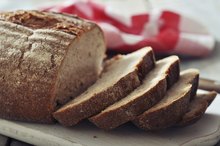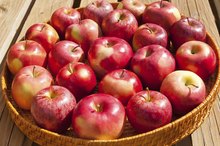What does fact checked mean?
At Healthfully, we strive to deliver objective content that is accurate and up-to-date. Our team periodically reviews articles in order to ensure content quality. The sources cited below consist of evidence from peer-reviewed journals, prominent medical organizations, academic associations, and government data.
The information contained on this site is for informational purposes only, and should not be used as a substitute for the advice of a professional health care provider. Please check with the appropriate physician regarding health questions and concerns. Although we strive to deliver accurate and up-to-date information, no guarantee to that effect is made.
Are Whole-Grain Breads Good for Constipation?
A diet low in fiber can exacerbate the constipation you may occasionally experience, according to the National Institutes of Health. Eating too much food made from white flour and refined sugars can prevent you from consuming enough fiber from foods such as whole-grain breads. Other causes for constipation include medications, inadequate hydration and some diseases.
Dietary Requirements
Whole-grain bread is in the grains group on the U.S. Department of Agriculture’s food pyramid. The 2010 Dietary Guidelines for Americans recommend that at least half of your 5 to 7 oz. of grain foods come from whole grains such as whole-grain bread. You need 22 to 28 g of fiber as an adult woman, and 28 to 34 g of fiber as an adult male.
- Whole-grain bread is in the grains group on the U.S. Department of Agriculture’s food pyramid.
Types
Fiber Foods and Messy Stool
Learn More
Whole-grain breads encompass more than just bread made from whole-wheat flour. When purchasing commercially prepared breads, examine the label to ensure that you see the words “whole wheat” or “whole grains” in the first few ingredients of the bread. Among the healthiest breads are those that contain the most fiber per serving, advises MayoClinic.com.
Fiber Content
Whole-grain bread made with 100 percent whole-wheat flour contains 1.9 g of fiber per slice, according to the USDA National Nutrient Database. Other whole grain breads such as rye, oatmeal and pumpernickel contain 1.9, 1.1 and 2.1 g of fiber per slice, respectively. If you make your own whole-grain bread or rolls, 1/2 cup of buckwheat flour has 6 g of fiber, and whole-wheat flour has 7.3 g per 1/2 cup. The higher the fiber content of your whole-grain bread, the easier it is to eat enough fiber to help relieve your constipation.
- Whole-grain bread made with 100 percent whole-wheat flour contains 1.9 g of fiber per slice, according to the USDA National Nutrient Database.
- If you make your own whole-grain bread or rolls, 1/2 cup of buckwheat flour has 6 g of fiber, and whole-wheat flour has 7.3 g per 1/2 cup.
Strategies
Calories in a Slice of Whole-Grain Bread
Learn More
If you suddenly increase the amount of fiber you consume, you will likely experience bloating and gas pains rather than simply relieve your constipation. Registered dietitian Joanne Larsen recommends adding foods high in fiber to your diet slowly 1. If you are accustomed to eating mainly white bread and few other foods high in fiber, plan on eating 10 g of fiber per day for one week, and adding additional fiber each week until you are eating the required amount of fiber every day. Avoid getting all of your fiber from whole-grain breads, but instead include:
- high-fiber vegetables
- fruits
- beans
- nuts
- seeds in your dietary plan
- If you suddenly increase the amount of fiber you consume, you will likely experience bloating and gas pains rather than simply relieve your constipation.
Related Articles
References
- Ask the Dietitian; Fiber & Constipation; Joanne Larsen, R.D.
- Veronese N, Solmi M, Caruso MG, et al. Dietary fiber and health outcomes: an umbrella review of systematic reviews and meta-analyses. Am J Clin Nutr. 2018;107(3):436-444. doi:10.1093/ajcn/nqx082
- Slavin JL, Lloyd B. Health benefits of fruits and vegetables. Adv Nutr. 2012;3(4):506-516. doi:10.3945/an.112.002154
- Raspberries, raw. FoodData Central. U.S. Department of Agriculture. Published April 1, 2019.
- Edamame, shelled. FoodData Central. U.S. Department of Agriculture. Published April 1, 2019.
- El-Salhy M, Ystad SO, Mazzawi T, Gundersen D. Dietary fiber in irritable bowel syndrome (Review). Int J Mol Med. 2017;40(3):607–613. doi:10.3892/ijmm.2017.3072
- Ma Y, Hu M, Zhou L, et al. Dietary fiber intake and risks of proximal and distal colon cancers: A meta-analysis. Medicine (Baltimore). 2018;97(36):e11678. doi:10.1097/MD.0000000000011678
- Ma Y, Olendzki BC, Wang J, et al. Single-component versus multicomponent dietary goals for the metabolic syndrome: A randomized trial. Ann Intern Med. 2015;162(4):248-57. doi:10.7326/M14-0611
- Kim Y, Je Y. Dietary fibre intake and mortality from cardiovascular disease and all cancers: A meta-analysis of prospective cohort studies. Arch Cardiovasc Dis. 2016;109(1):39-54. doi:10.1016/j.acvd.2015.09.005
- Hajishafiee M, Saneei P, Benisi-Kohansal S, Esmaillzadeh A. Cereal fibre intake and risk of mortality from all causes, CVD, cancer and inflammatory diseases: a systematic review and meta-analysis of prospective cohort studies. Br J Nutr. 2016;116(2):343-52. doi:10.1017/S0007114516001938
- U.S. Department of Health and Human Services and U.S. Department of Agriculture. 2015 – 2020 Dietary Guidelines for Americans. 8th Edition.
- Juraschek SP, Miller ER 3rd, Weaver CM, Appel LJ. Effects of sodium reduction and the DASH diet in relation to baseline blood pressure. J Am Coll Cardiol. 2017;70(23):2841–2848. doi:10.1016/j.jacc.2017.10.011
Writer Bio
Diane Lynn began writing in 1998 as a guest columnist for the "Tallahassee Democrat." After losing 158 pounds, she wrote her own weight-loss curriculum and now teaches classes on diet and fitness. Lynn also writes for The Oz Blog and her own blog, Fit to the Finish. She has a Bachelor of Science in finance from Florida State University.









